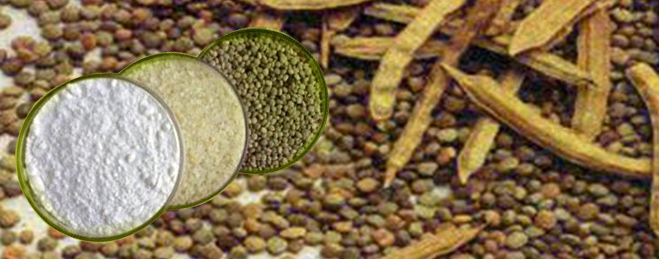
Guar Gum
Guar - A Wonder Crop | What is Guar Gum? | Uses | Exports | U.S. Buyer Inputs
HomeGuar Gum

Guar gum, also called guaran, is a galactomannan. It is primarily the ground endosperm of guar beans. The guar seeds are dehusked, milled and screened to obtain the guar gum. It is typically produced as a free-flowing, pale, off-white-colored, coarse to fine ground powder
Guar is grown mainly in India, Pakistan, Sudan and parts of USA. India grows over 850,000 tons, or 80% of the total guar produced all over the world. Mainly in Rajasthan 65% of the Guar Gum or derivatives produced in India are exported, mainly to USA and to European countries.
70% of India's Guar is grown in Rajasthan, and the balance mainly in Haryana, Gujarat and Punjab. Guar is grown in semi-arid climate and contains a protein and natural polymer. The protein along with the husk is used as animal feed and the natural polymer is used as a thickener to viscosify water.
India's much neglected and little-known guar gum is now its biggest agricultural item of export, upstaging the much better known items of basmati and non-basmati rice. Major uses today are in Textile Printing Thickeners, Oil and Gas Well drilling & Fracturing, Water based Paints, Building and Construction, Cosmetics & Personal Care, Food ingredients, etc.

Guar Gum, also called guaran, is derived from endosperm of the guar plant (Cyamopsis tetragonolobus). Guar is a legume crop, which grows best in sandy soils and needs moderate, intermittent rainfall with lots of sunshine.
Guar gum is a natural high molecular weight polysaccharide galactomannan, with a mannose to galactose ratio of 2:1, combined through glycosidic linkages. The guar seeds are dehusked, milled and screened to obtain guar gum. It is typically produced as a free-flowing, pale, off-white-colored, coarse to fine ground powder, which is available in different viscosities and granulometries depending on the applications.



The traditional market for Guar Gum is as an additive in the food industry. In the U.S., differing percentages are set for its allowable concentration in various food applications. In Europe, guar gum has EU food additive code E412.
Today, the usage and Exports of Guar Gum are in majority cases in Industrial Applications.

|
|
SHEFEXIL has maintained a healthy growth in guar gum export over the years, especially boosting since 2011-12, fuelled by increasing industrial uses across the world.
The primary destination of Indian guar gum has been USA, followed by China and Germany, and also 11 other countries including South Africa, UAE, UK, Italy, Netherlands, Hong Kong and Japan.

The export performance of guar gum over the years is highlighted in green in the chart below, along with the projection for 2012-13 and 2013-14 highlighted in orange:


A reputed buyer from the United States of America shared certain relevant views on how the world perceives Indian guar gum, which are detailed below.
In order to maximize return on investment, Guar manufacturers should focus on all the three above mentioned factors. For example, one can take a an average quality guar split and process it in a manner that will yield very high quality guar - which will be a highly efficient thickener.
Guar splits of any quality can also be chemically modified to increase its performance (or valued added). This derivatized Guar is normally used for Industrial Applications like:


In recent times in oil field business, there has been a significant increase in demand for guar both natural and derivatized guar. This increase in demand has been due to primarily in increase in an area of activity called Hydraulic Fracturing (HF).
Just on 18 month period, there has been a 50% jump in hydraulic fracturing activities. Typical HF uses either guar ( natural or modified) and Poly Acryl Amide (PAM). Typically 60% HF jobs are done with PAM and 40% are done with guar.
As we have indicated demand for oil field applications for guar has gone up and supply from India has grown up substantially. However, Prices need to be kept reasonable or else the oil field companies may be compelled to find other sources to replace guar.
Indian manufacturers even today do not know how to Derivatize Guar which is a value added. Very few also really know how to manufacture high quality HVG ( US Patent : Deysarkar, Dadoo etal). These value additions must be learnt if India as a country must earn more for their raw materials.